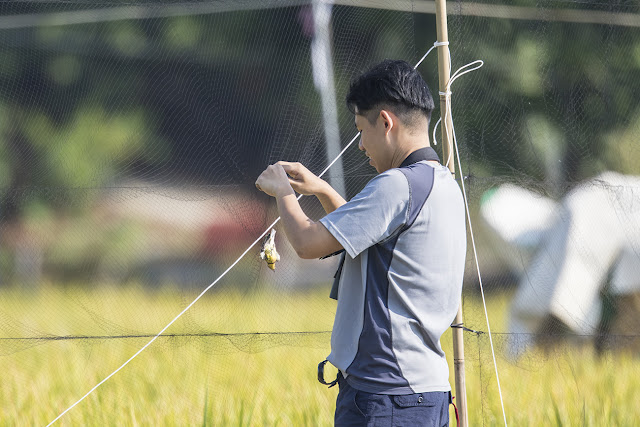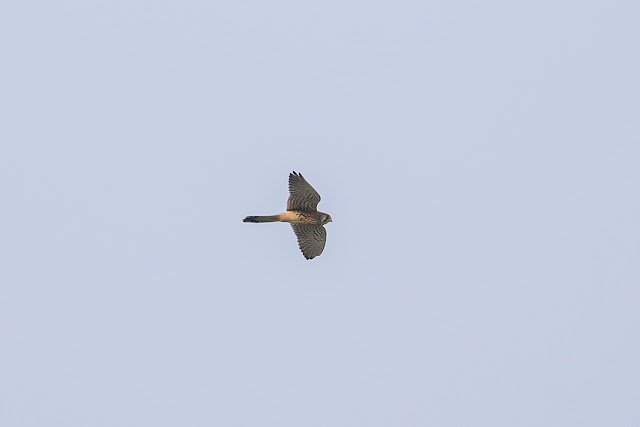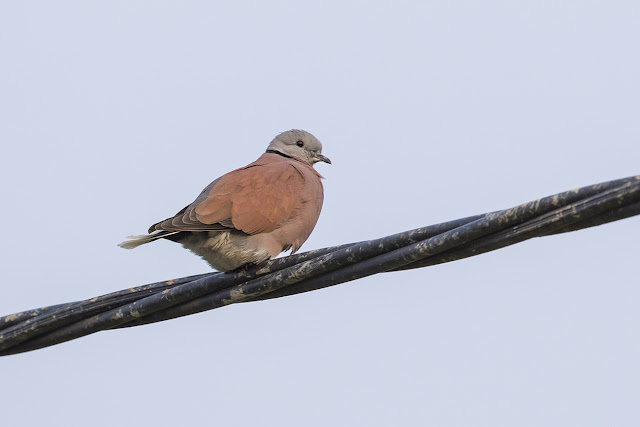Plaintive Cuckoo - rufous morph
Decided to head to Long Valley Wednesday morning to look for some Buntings, reports of more Yellow-breasted Buntings as well as a few other species returning certainly was an attraction. Turns out my visit coincided with HKBWS's bird ringing, their main target was obviously the increasingly rare Yellow-breasted Buntings. I was just in time to witness the first one hitting the net, they caught two that morning. Setting a mist net up at the paddies sure will get you some 'bycatches', including this Oriental Reed Warbler.
Yellow-breasted Bunting successfully netted
Oriental Reed Warbler - the unfortunate 'bycatch'
Outside the mist nets I saw quite a few Yellow-breasted Buntings, a few allowed quite good views while perched on a tree next to the paddies. This species is under a lot of pressure from trapping in China, where they are seen as a delicacy in some places. They are currently an endangered species but could be uplisted to critically endangered in the near future. The demand for these small birds had only grown with people earning more money, being able to pay high prices for these small birds. It is ridiculous to think that to present day eating wildlife is still a huge problem which threatens the very existence of a species, you would think humans had learnt from past mistakes from species like the Passenger Pigeons or Great Auks...I only managed a few Chestnut-eared Buntings as well as Little Buntings, although the later did not allow any close views.
Yellow-breasted Bunting - female
Chestnut-eared Bunting
Other then Buntings, there were a few Eurasian Skylarks around, they are uncommon migrants that passes through every year. Dusky Warblers were now everywhere.
Eurasian Skylark
Dusky Warbler
Kenneth Lam and two his friends joined me mid morning, although things slowed down slightly. A pair of rufous morph Plaintive Cuckoos were around, allowing quite good views. They were extremely conspicuous and quite confiding, although I have found the general behaviour of this species may vary between individuals. One of the better bird was a Japanese Sparrowhawk which drifted past, it never came towards us for a better view though. We were greeted by a confiding Black Drongo as we exited Long Valley towards Ho Sheung Heung, it reminded me of the one I rescued not long ago, I wonder how that one is doing.
Plaintive Cuckoo - rufous morph
Japanese Sparrowhawk
Black Drongo
After lunch, Kenneth and I decided to head into San Tin to look for the Daurian Starling that Captain saw the day before. We got to the supposed location and waited, although there weren't that many Starlings around, but sitting on the ledge of the car boot revealed to be quite effective, as we continued to add different species onto our day list. A lot of Whiskered Terns drifted past us, feeding along the fish ponds.
Whiskered Tern
We started scanning the sky for Amur Falcons as Kenneth had yet to get them on his Hong Kong list, and falcons we got! Although the first was a Kestrel which gave us a scare, but it was going the wrong direction, and the shape was completely wrong once you get a better look. We also got a Eurasian Hobby, it was drifting quite high up but the lack of darker secondaries and primaries ruled out Amur. Finally, a proper Amur Falcon drifted past, although quite distant we could pick out all the diagnostic details. We counted a few more Amur Falcons after this.
Eurasian Kestrel
Eurasian Hobby
Amur Falcon
Starlings started appearing much later, we had over a hundred, both on the wire and on a fruiting tree near by, we kept scanning for any Daurian Starlings, but all we had were Silky Starlings, White-shouldered Starlings, White-cheeked Starlings and Black-collared Starlings. Suddenly, Kenneth spotted a bird in flight and asked what that was, I managed to pick it up with my bins and recognised it as a Lark, although it felt wrong for a Eurasian Skylark which I only saw in the morning. Kenneth was quick enough to get a few shots off and we examined the photo and quickly suspected it for rarer species of Larks. After some consultation with other birders, we came to a conclusion that this was a Mongolian Lark. Problem with these Lark species is that they are such popular cage birds in Hong Kong, that although there had been Mongolian Larks recorded in the past, all of them had been rejected...The general reaction for this bird was also the same. The final decision shall be made by the record committee, although one thing that birding had taught me is to expect anything and everything. It's difficult to proof it as a wild bird, but actually it's equally difficult to proof that it's not, I think only the bird knows whether it came to Hong Kong unassisted.
Starlings...but no Daurian!
Mongolian Lark (photo by Kenneth Lam)
Finally, a pair of Red Turtle Dove which allowed quite good views as we exit San Tin to round up the day nicely.
Red Turtle Dove - male (above) & female (below)



















To think that humans will ever learn from past mistakes, Matt, is a vain hope indeed.
ReplyDeleteIndeed, but I guess all we naturalists can do is to try and promote and educate the importance of these species to as many as we can...
Delete